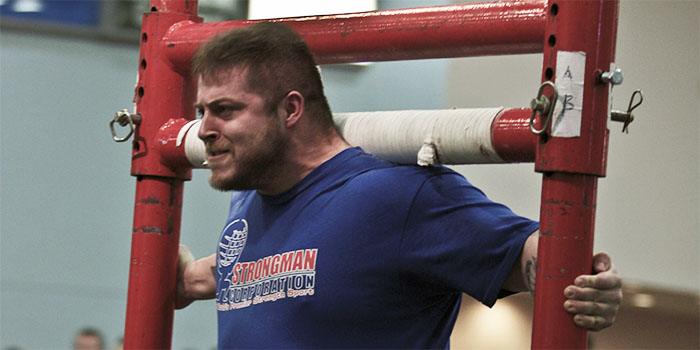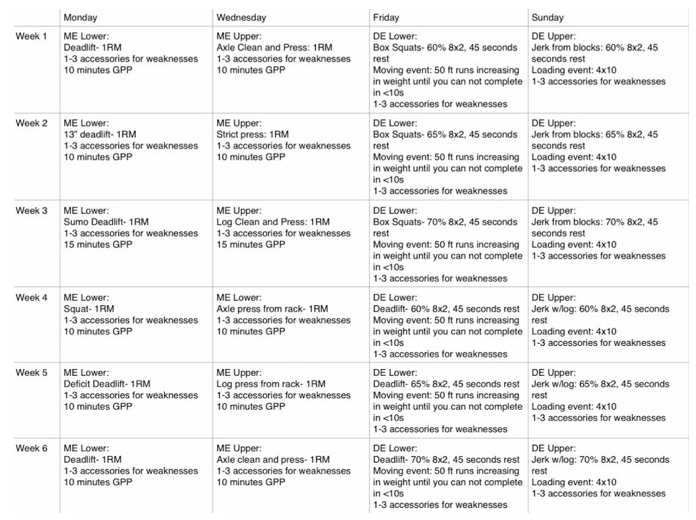
If you’ve been in the strength game for more than a minute, you’ve at least heard the term conjugate. A lot of people seem to misunderstand what that means, and even further, strongmen seem to have a lot of trouble adapting it to their training. Personally, I think it can be an extremely effective system for strongmen and women who have moved into the intermediate level of strongman and are looking for a way to keep things moving forward.
Before we get into the meat and potatoes, let’s go over the conjugate method and why it applies well to strongman. The conjugate method, or “concurrent method”, is a training methodology in which you train for multiple adaptations at the same time, or concurrently. This fits perfect with strongman for a few reasons. First, strongman requires speed, endurance, strength, and explosiveness. The strongest athlete will always beat the strongest man. Being able to train for all those attributes at the same time will yield amazing results, and the conjugate method is the perfect way to get there.
MORE: The Continental Clean — Maximizing Your Axle Clean and Press
Second, training for competitive strongman is brutal. There is no way around it. There is almost an infinite number of events that you need to be proficient at in order to be a well-rounded athlete. Being able to cycle through different events in the off-season and add those skills to your arsenal will make you a much better athlete.
Now, you may be asking yourself, “What qualifies me as an intermediate strongman?” In my view, it means that you’ve been training at least one to two years, you’ve competed a few times in the open class, and, most importantly, what worked in those first one to two years isn’t working anymore. We all come to that point where progress stalls and things get frustrating. Moving out of a linear model into a conjugate model is a great way to help surpass those plateaus.
When putting together your plan, I suggest working on a four-day schedule. This will give you two max effort days (ME) and two dynamic effort days (DE). You will pick four to six main ME movements, do one each week, and keep cycling through them. Since the main static strength events in strongman are the deadlift and the overhead press, it is best to focus on those during your ME days. What exercises would I pick from?
Deadlift (ME Lower)
- From the Ground
- 13” Deadlift
- Sumo
- Deadlift from a Deficit
- Pin Pulls
Overhead Press (ME Upper)
- Strict Press Out of Rack
- Log Clean and Press
- Axle Clean and Press
- Bench Press
- Seated Strict Press
When performing these ME days, you will take each movement and work up to a max, cycling a different movement each week. This will allow you to train heavy each week without burning yourself out, which can lead to CNS fatigue and overuse injury. When planning your DE effort days, you have a few options. For lower body, I’m a huge fan of box squats. Because so many movements in strongman are hip-dominant (i.e. atlas stones, overhead throws, car deadlift) DE box squats will help you increase power from the hips. However, if you have a technical issue on a certain lower body lift, you can incorporate that into the rotation more often to work on form and ingrain patterns.
For upper body, jerks and push presses are great because they already have accommodating resistance built into them. Bench press and strict press can also be useful.
So, what does a DE day consist of? We’re looking to move weight as fast as possible and to recruit as many muscle fibers as possible. I know we usually think of chains and bands when it comes to DE days, and while they’re helpful, they aren’t necessary. As long as we have a weight that is heavy, but can be moved quickly, we can reap the same benefits. Think 60-70% of 1RM, for eight to 10 sets of two to three reps with 45-60 seconds rest between each set.
Okay, so we’ve got the basics set. How do we set it all up? Here is a basic six-week sample of how I would set things up for someone:
Looking at this chart, you may be wondering a few things. What is GPP, and what sort of moving and loading events am I referring to? GPP is General Physical Preparedness. Think in terms of prowler, sled drags, etc. It shouldn’t kill you, but you should be moving under stress for the duration of the time.
When it comes to moving and loading events, I think it’s good to cycle between them, in the same manner, you would with ME events (farmers walk, yoke walk, heavy sled drags, truck pulls, etc.). Getting your footwork down and moving fast is important when it comes to these. The same is true with loading events (i.e. stones, keg loads, sandbag loads).
Obviously, as you come closer to a competition, you’ll want to be more specific when it comes to events, which I will cover in the future. But for the off-season, a setup like this will help you increase your lifts and become more proficient in a wide array of events.












Great article. Training for Strongman is always a challenge and new ideas on how to incorporate proven training methodology to meet the unique needs of Strongman are always needed. How would you fit tire flip into this template? Would you use it as a second movement for DE lower?